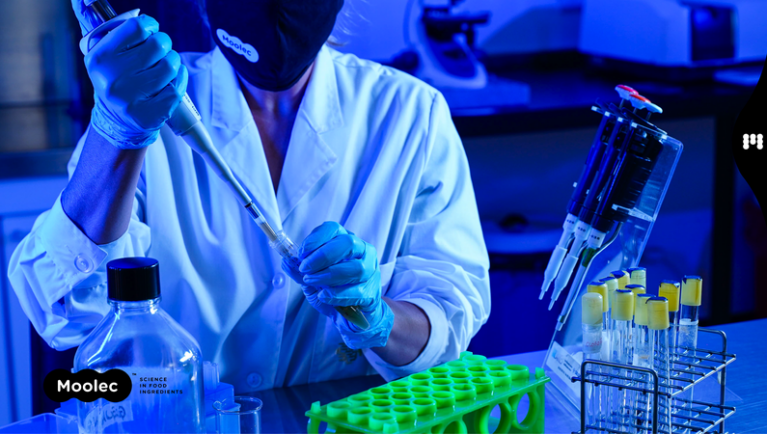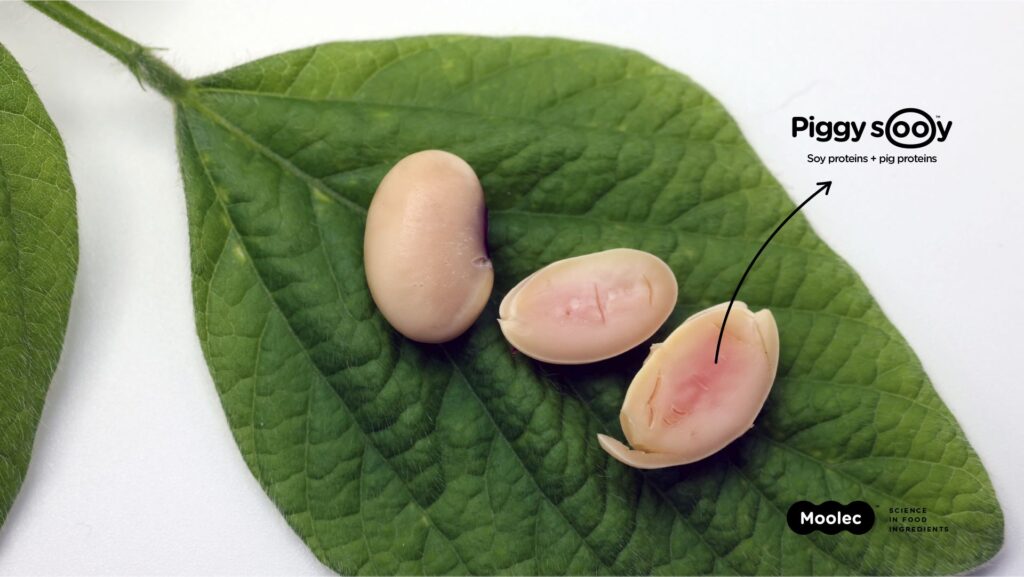
Part 2 of A Soybean Makeover.
Protein Boost from Pork?
Meanwhile, gene-editing technologies are allowing for precise modifications to genes and Moolec Science, a molecular farming biotech company has focused their attention on expanding the horizons of what plant protein can do, or be. Piggy Sooy, a genetically modified soybean, with a target of up to 26% of the total soluble protein in the bean, is the first of its kind.
“We are using a plant as a bioreactor,” says Martín Salinas, Moolec Science chief of technology and co-founder. “Compared to other technologies where you give the plant a new gene to increase productivity in the field, the aim of our technology is a bit different as we would like to change the plant output. We are producing new enzymes, proteins and molecules to boost the ingredients derived from the plant, or in the future, perhaps for extraction.”
The team settled on myoglobin as their initial target for a few reasons, namely its size and function, but that came with challenges as well.
“In the case of myoglobin, not only does the plant have to make the target protein but there is also a secondary heme molecule attached to it which is a bioavailable form of iron,” says Henk Hoogenkamp, Moolec’s chief product officer and co-founder.
He says it also provides a visual cue with the pink color.
This process is not without additional considerations such as allergen concerns and regulatory hurdles, however. In April 2024, The U.S. Department of Agriculture’s APHIS Regulatory Status Review (RSR) determined that Piggy Sooy was unlikely to pose an increased plant pest risk relative to non-engineered soybeans and thus, will not be subject to APHIS regulations for genetically modified crops.
Currently, the company is in field trials to determine how the plant is affected by the new protein sequence.
“What we’re seeing now is that since soybeans have so much protein already, that the 20% of the total protein we’re diverting to our target has not fully impacted the plant itself in the greenhouse and in a couple of months we’ll know what that impact was on the field,” Hoogenkamp says.
The company expects to release a variety to the market in 2028.

“The breeding variety that we used for Piggy Sooy is not a typical commercial variety that you would see on the farm,” Salinas explains. “Once we have this variety producing high levels of animal protein, we can then introduce our trait into the variety that we want, or into other varieties that will perform well in different territories and have resistances to other pests or other traits we will need.”
Moolec is also working on a beef protein project using pea plants and Hoogenkamp expects to see this technology applied to other seed components.
“We are showing what we can do with one protein first but we can also do other proteins, or shift the fatty acid profile, for example,” he says. “Many of these traits are not significant enough to make it to the market on their own, but we’re going to be able to breed them into other varieties and have the option to really build the bean we want.”
Sustainability Concerns
Even with improved genetics, difficult environmental conditions affect protein levels as well as yields. In Africa, in addition to yield, IITA focuses on rust resistance and drought tolerance, as well as branching varieties to compensate for low plant populations. In the US, most breeding programs focus on single-stem varieties.
“We are also focused on promiscuous nodulating soybeans which use rhizobium strains native to Africa to fix nitrogen because many African farmers are unable to apply inputs as in other parts of the world,” Chigeza says.
Especially in the face of climate change, he says it’s important for breeders to seek long-term sustainable solutions while protecting and enriching the germplasm for future generations.
“It takes at least ten to twelve years to bring a new variety to market, so we need to be working ahead,” Eskandari says. “I make 110 crosses every single year to mix up the genetics and select the best ones.”
Using molecular markers helps preserve genetic traits for the future when bringing new varieties to market.
“Specifically, for soybean cyst nematode (SCN) resistance, we have two markers that are linked to two major genes, Rhg-1 and Rhg-4 on chromosomes 18 and 8, respectively,” Eskandari says. “So, when we do the molecular analysis, we make sure to select the lines that have these markers, allowing us to efficiently narrow down several thousand lines to a few hundred that are likely resistant to SCN. This approach is highly cost-effective.”
Sudden death syndrome (SDS) pathogen is another climate-change related concern breeders are preparing to tackle.
“We know it’s on the horizon, so each year we make new crosses and incorporate known beneficial sources,” Eskandari says. “It’s important to have the reliable genes in the background and ensure we are continually enriching the germplasm of our cultivar development pipeline.”
Ultimately, it’s about ensuring the future of the world’s food supply, and Naeve says the seed industry can play an important role by increasing the protein in soybeans and other seeds.
“Humans require protein. The population is increasing. All protein starts with plants,” he adds.
The post Powering Up Plant Protein appeared first on Seed World.



